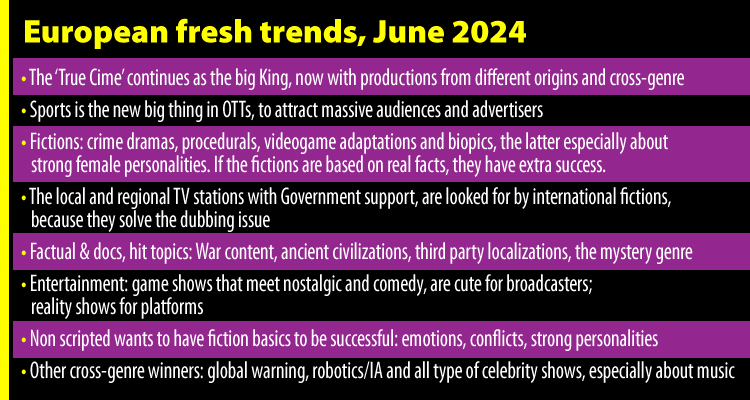This is a very special month for the content industry and for Prensario. For the first time, there are six good European events that we cover in person with print copies, the same edition for all: Content Warsaw, NEM Croatia (for the first time) MIFA/Annecy for kids, Natpe Budapest, Conecta Fiction for co-productions and Sunnyside for docs (for the first time). Last year we’ve been in three of them. We send three different teams to cover all these events in the same month. For the industry, it is a challenge to have so many events in Europe, in Summer, three focused on Central & Eastern Europe. But apart from Warsaw, all of them took place last year.

These so many events are not casual: if some years ago the medium shows went down and seemed that just the very big ones would survive, now there is a return to regional, local, niche events, as a way to find new, fresh people. It is another issue where content business returns to its basics, as in genres (all main buyers wanted procedurals in LA Screenings last month) in partners (free TV, vs OTTs) incomes (advertisement) and business models: the ‘major’ international distribution is firmly back (vs. OTT exclusivity). As we saw in May during LA Screenings, in Los Angeles.
There we’ve stressed, in our wrap-up, that content business has two evolutions together: progressive on one side, because digital, multiple-screens, social media, on demand, live streaming, IA, came for staying forever; but too, pendular on the other side, because business very often returns to traditional pillars as we’ve mentioned above. Who knows to move better among these twists, will make difference.
European fresh trends…
…to have in mind during June? At MIPTV, during ‘Thriving in the sport frenzy’, Scott Young, SVP sports content, WBD (UK), said: ‘Sports is the new big hit for platforms, that now consider the genre as another entertainment, not a genre apart. It is great to attract massive audiences and advertisers’.

At ‘Fresh TV Fictions’, Virginia Museler, The Wit, told: ‘What’s on top in fictions this year? Crime dramas, procedurals… especially True Crime. Also, videogame adaptations and biopics, based strong real (usually female) personalities’. Twists? An Indian distributor said: ‘This is a good moment for foreign suppliers, to approach regional broadcasters in Europe, as Basque TV or TV3 Catalunya in Spain, etc. They have budget vs. the national networks, to buy more and to afford the dubbing, supported by the local Governments’.
What’s up in factual & docs? A big AMC European buyer resumed: ‘War content. It is usually with ups & downs but now is strongly up. Also, ancient civilizations, especially Egypt. Third, the localization is key, so if you can’t produce, look for foreigners producing about your national relevant people. ‘True crime’ continues on the extreme top, but now not only US productions, but also from France, Spain and even the Nordics. The mystery genre, in a wide sense, is present everywhere now in factual, connected to other issue. What’s down? Factual character-driven series… there is less production’.
A new vein in entertainment formats? A major US studio format head, answered: ‘Nostalgic comedy games, that combine past with present, including figures of the channel to promote other programs’. Also, through all Europe, more and more OTTs look for reality formats. And non-scripted decision makers want to take fiction basics to be successful: emotions, conflicts, strong personalities. They use good fictions as a guide to select formats, comparing one to one their parts.
More tips cross-genre? Everything that includes global warming, ecologic topics… works. Every high-tech development, IA, robotics, is well demanded especially in entertainment. And also, all kinds of celebrity shows, as realities, home & health, lifestyle… anything with famous people: singers, millionaires, etc. The music factor is especially successful for these ventures.
Keys to open difficult regions, as CIS nations? Paloma García, Caracol Colombia: ‘Now we have the new local digital platforms, that need content and if you have success, you can approach broadcasters or bigger OTTs with a better background. To propose traditional female love stories is always good; to have dubbed series to universal languages as English, essential’.
The newest of the newest? The live streaming TV, which is undoubtedly a new TV emerging. It can happen with sole programs or with a full channel behind… it has its own rules and ecosystem, with hundreds of projects being launched. The good thing is that who makes the things well, as programs with TV young stars and good productions, find that advertisers come close, instead of searching them. They like the full digital media, the young targets and maximum segmentation.
Good or bad global moment?
As we said about evolution, there is a double face too for the content market moment. On one hand, many industry members talk about a ‘global crisis’: broadcasters are complicated due to advertisement hyper fragmentation; the SVODs have created a production bubble, that now must be adapted to real business, and they need advertisement to compensate flat subscriber incomes; most of AVOD/FAST media move themselves by revenue sharing and with low budgets. All of these push big suppliers to structure and budget reductions.
But on the other hand, the market is naturally growing, with a lot of new media emerging: digital platforms, social media, etc. While other segments suffer main buyer mergers, in content business the major international distribution is back and there is a big amount of new channels looking for programming. The clear challenge to make a global step ahead, is to monetize the new ventures: broadcasters opening OTTs, the SVOD titans launching AVODs, the network operators turning into aggregators, etc.
Advertisement? It seems always the answer. A good decision would be for the emergent media, to hire digital expert managers, that come from managing Youtube, AWS, Google partners, etc., to get know-how about the new ways of generating incomes. In our reports, we stress that the advertisement spending as a whole is in record levels, the problem is that if before there were 4-5 big media, now there are dozens or even more. New young ventures as live streaming, are in the preference of ad agencies, as we told above. The new times need new approaches…
Nicolás Smirnoff







